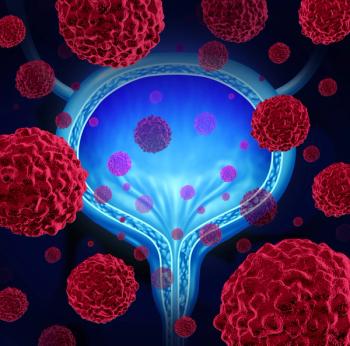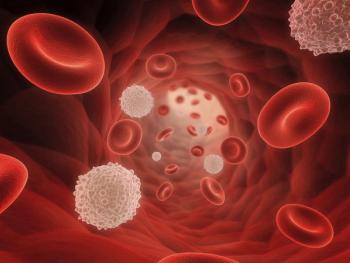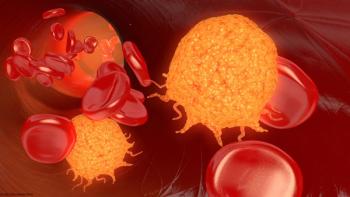
Apalutamide/ADT Displays Long-Term Efficacy in Recurrent Prostate Cancer
Previous results from the study found improvement in the primary end point of PSA-PFS with apalutamide in recurrent prostate cancer.
The addition of apalutamide (Erleada) to androgen deprivation therapy (ADT) reduced the risk of developing metastases and castration-resistant disease vs ADT alone among patients with biochemically recurrent prostate cancer, according to a presentation of the phase 3 PRESTO trial (NCT03009981) findings at the
Preplanned and post hoc analyses from the study found improvements in metastasis-free survival, time to castration-resistant prostate cancer (CRPC), prostate-specific antigen progression-free survival (PSA-PFS) in the testosterone-recovered subset, and time to subsequent therapy.
“Combined androgen blockade with ADT plus apalutamide appears to improve clinically relevant long-term end points,” said Rahul Aggarwal, MD, Thomas Perkins Distinguished Professor in Cancer Research at the University of California San Francisco, in his presentation of the data.1 “The study was not powered to detect differences between the experimental arms. The further addition of abiraterone [Zytiga] with prednisone did not appear to lead to further benefit and was associated with increased toxicity.”
Patients with biochemically recurrent prostate cancer with a short PSA doubling time are at risk of progression and distant metastatic disease. The PRESTO study randomly assigned patients 1:1:1 to receive a luteinizing hormone–releasing hormone (LHRH) analogue alone, LHRH analogue plus apalutamide, or LHRH analogue, apalutamide, abiraterone, and prednisone for up to 12 months.
Previous results from the study found improvement in the primary end point of PSA-PFS in both experimental arms, leading to ADT plus apalutamide being considered a viable treatment option in high-risk biochemically recurrent prostate cancer.2,3 Additionally, the addition of apalutamide and abiraterone did not negatively affect health-related quality of life in patients.
The enrolled patients had prior radical prostatectomy, biochemical recurrence with PSA greater than 0.5 ng/mL, PSA doubling time of 9 months or less, and no metastases on conventional imaging. They had received their last dose of ADT more than 9 months prior to study entry and could have received prior adjuvant or salvage radiation therapy unless they were not a candidate for radiation.
Patients were stratified by PSA doubling time of less than 3 months or between 3 and 9 months. Metastasis-directed therapy was not permitted until PSA progression during the 12 months of treatment, and patients then received imaging every 6 months until detection of the first distant metastasis.
The baseline characteristics of the study population were generally well-balanced across all 3 treatment arms, with a median PSA at study entry of 1.8 ng/mL. Approximately a quarter of patients had a PSA doubling time of less than 3 months at study entry, and 85% had received prior adjuvant or salvage radiation. Prior ADT in conjunction with local therapy had been given in 42%.
Of 503 patients who were randomly assigned to treatment, 444 (88%) completed treatment and 497 completed follow-up with a median follow-up of 61.0 months. The database freeze for reporting of secondary end points was July 7, 2025.
In terms of metastasis-free survival, 59 of 168 patients had events with apalutamide plus ADT vs 67 of 166 with ADT alone, resulting in a Cox proportional HR of 0.80 (95% CI, 0.56-1.13) with the proportional hazards assumption being violated. There was a difference of 2.92 months of restricted mean survival over the first 48 months, favoring the combination. With the addition of both apalutamide and abiraterone vs ADT alone, the HR was 0.92 (95% CI, 0.56-1.13) with a difference in restricted mean survival over the first 48 months of 2.41 months (95% CI, –0.20 to 4.62).
With 20% of patients developing CRPC between the apalutamide and ADT alone arms, the HR of 0.58 (95% CI, 0.36-0.95; nominal P = .0283) favored apalutamide plus ADT. Comparing the apalutamide, abiraterone, and ADT with ADT alone, the HR was 0.55 (95% CI, 0.34-0.90; P = .0176).
Looking at the testosterone-recovered subset of patients, “the median time to testosterone recovery greater than 150 was generally similar between ADT plus apalutamide vs ADT alone, and in total, approximately 80% of patients recover their testosterone to greater than 150 [ng/mL] in this testosterone-recovered subgroup,” Aggarwal noted.
The PSA-PFS outcomes favored apalutamide plus ADT vs ADT, with an HR of 0.72 (95% CI, 0.55-0.93; P = .0283). They also favored apalutamide and abiraterone plus ADT vs ADT, with an HR of 0.67 (95% CI, 0.50-0.90; P = .0075).
A post hoc analysis was done on time to subsequent therapy, including focal and/or systemic therapy, for the trial population. Looking at apalutamide plus ADT, 55% of patients received subsequent treatment, with a median time to subsequent treatment of 47.6 months with the combination vs 35.7 months with ADT alone (HR, 0.75; 95% CI, 0.56-1.00; P = .0075).
Looking at apalutamide and abiraterone plus ADT, 53% of patients received subsequent therapy and the median time to treatment was 52.8 months with the combination vs 35.7 months with ADT alone (HR, 0.64; 95% CI, 0.47-0.86; P = .0028).
In terms of safety, adverse events (AEs) were reported in 96% of the ADT arm, 100% of the ADT plus apalutamide arm, and 99% of the ADT plus apalutamide and abiraterone arm. Grade 3 or 4 AEs were reported in 22%, 26%, and 41%, and AEs led to discontinuation in 0.6%, 1%, and 2%, respectively.
In the apalutamide plus ADT arm, “there were more patients with grade 2 or higher skin rash and slightly higher risk of falls. However, the risk of fatigue and hot flashes was generally similar compared to the ADT control arm,” said Aggarwal. “In contrast, with the further addition of abiraterone with prednisone, we observed increased toxicity,” he added, noting a 21% rate of grade 3 or higher hypertension in this arm.
Although the study was not powered to compare the 2 experimental arms, the addition of abiraterone resulted in greater toxicity and did not appear to lead to greater efficacy than apalutamide plus ADT.
Aggarwal noted several limitations of this study and the secondary outcomes. Next-generation imaging such as fluorine F 18 fluciclovine or prostate-specific membrane antigen PET scans were not used as they were not standard of care at the time, and with these modalities being used, fewer patients are staged with no metastases. The study was relatively underpowered for the long-term end points, and there was no central imaging review.
Additionally, metastasis-directed treatment such as radiation therapy being disallowed before PSA progression limited the conclusions drawn. “The role of combined androgen blockade coupled with metastasis-directed therapy for oligometastatic, metachronous prostate cancer remains to be defined from ongoing studies,” Aggarwal said.
References
- Aggarwal R, Hillman D, Xiao H, et al; Alliance AFT-19 Study Investigators. Final results from PRESTO: a phase 3 open-label study of combined androgen blockade in patients with high-risk biochemically relapsed prostate cancer (AFT-19). Abstract presented at: European Society for Medical Oncology Congress 2025; October 17-20, 2025; Berlin, Germany. Abstract LBA88.
- Aggarwal R, Heller G, Hillman DW, et al. PRESTO: a phase III, open-label study of intensification of androgen blockade in patients with high-risk biochemically relapsed castration-sensitive prostate cancer (AFT-19). J Clin Oncol. 2024;42(10):1114-1123. doi:10.1200/JCO.23.01157
- NCCN. Clinical Practice Guidelines in Oncology. Prostate cancer, version 2.2026. Accessed October 19, 2025.
Newsletter
Stay up to date on recent advances in the multidisciplinary approach to cancer.

















































































